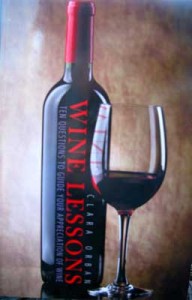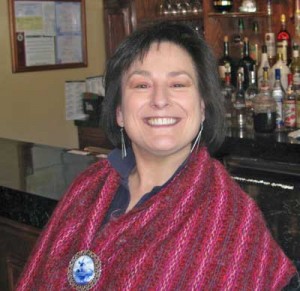Interview with Chicago Wine Author Clara Orban
Recently, Midwest Wine Press spent time with Clara Orban, the author of Wine Lessons: Ten Questions to Guide Your Appreciation of Wine. Clara not only chairs the Department of Modern Languages at DePaul University in Chicago, she’s also a Certified Sommelier. Much of Clara’s book examines the intersections of wine, geography and history.
Your book is an interesting study of the relationship between wine and geography. Most wine regions are near oceans or waterways that connect different countries or regions. By comparison, we’re relatively landlocked. How does our mid-continental location affect the Midwest’s potential to become a player in the global wine industry?
What you do is more important than where you are. Recently, I was at an airport in Washington State and there is a store at the airport that sells Washington wine. There’s also a gift shop in the airport in Des Moines that sells Iowa wine. In Chicago, we have a large international airport, but I don’t know of any place at the airport that sells Illinois or Midwest wine. Wouldn’t it be great if an international traveler passing through Chicago could take home a bottle of local wine? Ideas like that are how a wine region can gain awareness.
In your book, there’s a chapter on Southern Illinois wine and Kite Hill Vineyards in Carbondale, IL. In this chapter, you describe Midwest winemakers as “modern day equivalent(s) of the pioneers.” As pioneers, should Midwest winemakers follow established wine making traditions, or is the time right to create a new paradigm?
For Midwestern wineries, it makes sense to determine your niche regardless of per-determined traditions like “new world” or “old world” wine making. Winery owners should be thinking in the context of “where do I want my wines consumed.” Take the example of Swiss wine. The Swiss produce a small amount of very high quality wine that costs around $35 US dollars a bottle. At this price level, they can’t export their wine so it mainly gets consumed very close to where it was made. Is this the direction the Midwest wants to go, selling an artisan product close to home for a premium?
Also, I would encourage Midwest winemakers to experiment. For example, how about using hybrid grapes to make a Beaujolais style wine using carbonic maceration?
 As a leading language educator and perhaps the only head of a university language department who is also a sommelier, how would you suggest building a wine vocabulary, especially for someone who is new to wine?
As a leading language educator and perhaps the only head of a university language department who is also a sommelier, how would you suggest building a wine vocabulary, especially for someone who is new to wine?
As language teachers, we know that learning a new language takes time and patience. Developing a wine vocabulary is a two-part process. First, start to develop what I call a “label vocabulary.” This means understanding where a wine is made and from what kind of grapes. Over and over, we see students confusing the grape name with the place the wine was made.
As you get more interested in wine and know what you like, start to focus on the geography of the wine. Where was it made? Also, learning the history of where a wine is made enhances the whole wine experience.
The second part of developing a wine vocabulary is learning words to describe wine at tastings. Wine is a social activity so attend tastings and drink wine with friends who like to talk about it.
Millennial wine drinkers have been described as “global browsers.” In other words, they drink wine from all over the world without becoming attached to any one particular area. Do you support a globetrotting approach to wine or do you think it’s more satisfying to be knowledgeable with just a few wine regions?
I like the idea of being an eclectic wine drinker and being open to many different areas. It makes me sad whenever I hear someone say, “I would never drink a wine from that area.” Eventually, you want to find a style of wine that makes you happiest. But I would not say that millennial browsing is a bad thing. Young wine drinkers can bring about revival of old styles of wine. For example, until recently Muscato was on the sidelines until a new generation of wine drinkers brought it out of retirement.
In your book, you mention that men have traditionally ruled the wine world. Do you think there are gender specific wine preferences?
Studies have shown women have a better sense of smell than men, but I don’t think there is a genetic predisposition for women to like certain kinds of wine. I think wine preferences are more the product of social conditioning.
Wine marketers appeal to men and women differently so the sexes gravitate to certain wines because they think that’s what they’re supposed to do. Red wine is normally marketed to men. That’s because red wine is heavy and it does not go well with chatting with friends which women like to do when they drink wine. For women wine drinkers, I would be careful around wines that fawn to female consumers.
Wine Lessons: Ten Questions to Guide Your Appreciation of Wine is available on amazom.com
[wp_geo_map]



Good interview. She is just beginning the process of writing a book about Illinois wineries.